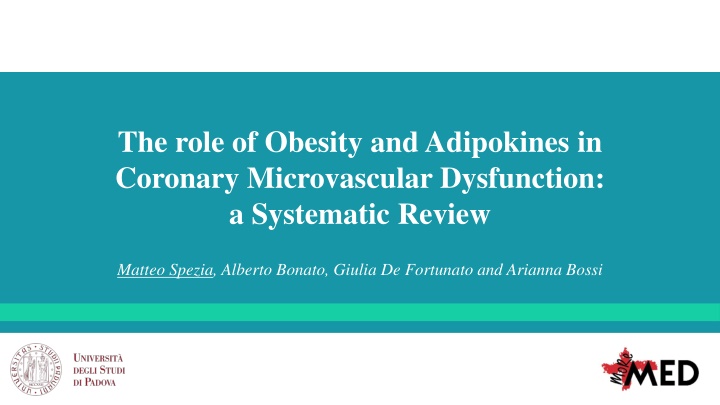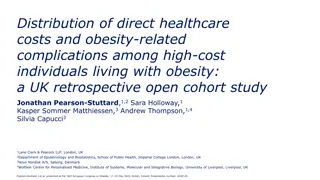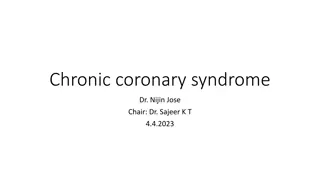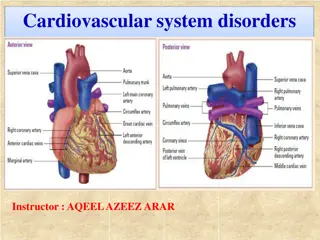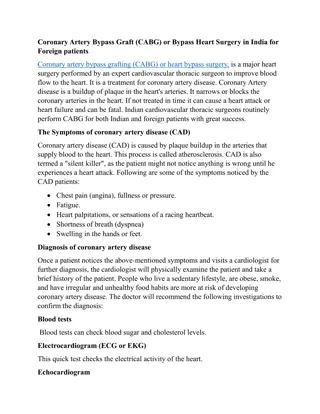Role of Obesity in Coronary Microvascular Dysfunction: A Review
Obesity is a prevalent risk factor for cardiovascular diseases, associated with chronic inflammation and adipokines dysregulation that may contribute to coronary microvascular dysfunction (CMD). The study investigates the impact of obesity and molecular changes on CMD development, emphasizing the importance of understanding these mechanisms in cardiovascular health.
Download Presentation

Please find below an Image/Link to download the presentation.
The content on the website is provided AS IS for your information and personal use only. It may not be sold, licensed, or shared on other websites without obtaining consent from the author.If you encounter any issues during the download, it is possible that the publisher has removed the file from their server.
You are allowed to download the files provided on this website for personal or commercial use, subject to the condition that they are used lawfully. All files are the property of their respective owners.
The content on the website is provided AS IS for your information and personal use only. It may not be sold, licensed, or shared on other websites without obtaining consent from the author.
E N D
Presentation Transcript
The role of Obesity and Adipokines in Coronary Microvascular Dysfunction: a Systematic Review Matteo Spezia, Alberto Bonato, Giulia De Fortunato and Arianna Bossi
Introduction - Obesity is one of the most diffuse and increasing conditions of our age, it is also a well-known risk factor for cardiovascular diseases - Obesity is associated with a low chronic state of inflammation and dysregulation of adipokines secretion that could be linked to coronary microvascular dysfunction (CMD) - CMD is defined as a reduced coronary reserve flow in absence of obstructive coronary artery disease (CAD)
Introduction - A substantial proportion of patients with angina symptoms undergoing invasive diagnostic coronary angiography does not present obstructive coronary artery disease - These patients might have an underlying, and often undetectable, microvascular dysfunction - The role of obesity in the development of CMD still remains poorly understood.
Objective To aim of the present study is to investigate the crucial role of obesity and its molecular alterations in the pathogenesis, progression and severity of CMD development Obesity Adipokines Coronary Microvascular Dysfunction
Methods - A systematic review was performed by searching PubMed, Embase and Cochrane Library database - Studies of any level of evidence published in peer reviewed journals were included - PRISMA guidelines were applied and risk of bias was assessed, as well as the methodological quality - After this assessment, we excluded all the articles with serious risk of bias and/or low quality
Methods Additional records identified through EMBASE (n = 10) Records identified through PubMed searching (n = 304) Additional records identified through Cochrane Library (n = 11) Identification 8 articles on human and animal literature, assessed as medium or high quality, were included Records after duplicates removed (n = 312) Screening Records excluded by reading title and abstract (n =271) Records screened (n =312 ) We examined the data of 593 patients Eligibility Full text excluded with reasons: (n = 33) The topic was not the one investigated in this review (n= 28) Review article outdated(n=3) Serious risk of Bias (n=2) Full-text articles assessed for eligibility (n = 41) Included Studies included in qualitative synthesis (n = 8)
Results Overall, CFR was shown to be significantly reduced in patients with obesity The same trend was found evaluating pharmacological induced stress MBF, which was reduced in patients with obesity, without obstructive coronary artery disease. Nevertheless, MBF at rest did not show a significant difference in patients with obesity from our analysis.
Results The level of adipokines, in particular of IL-6, TNF-alpha, adiponectin and leptin resulted increased in patients with abnormal CFR. Increase in leptin and CRP, along with reduction in adiponectin plasma levels in obese individuals, correlated with a significant decrease of stress-induced MBF.
Limitations - Heterogeneity of the studies and of the reported data - Different methods were used to assess the cardiac function - Most of the included studies were retrospective and cross-sectional but no randomized controlled clinical trial was found - The study is based only on observational evidence that did not show causation but only association
Conclusions Obesity is associated with a significant higher risk of developing coronary microvascular disfunction, which is reflected by diminished CFR and stress MBF. Systemic inflammation and adipokines imbalance related to obesity has been closely linked to a blunt coronary flow. Further evidence is required to clear out the role of Obesity from a molecular point of view on the coronary endothelium
Grazie! For any question or comment, you can email me at: matteo.spezia@studenti.unipd.it
